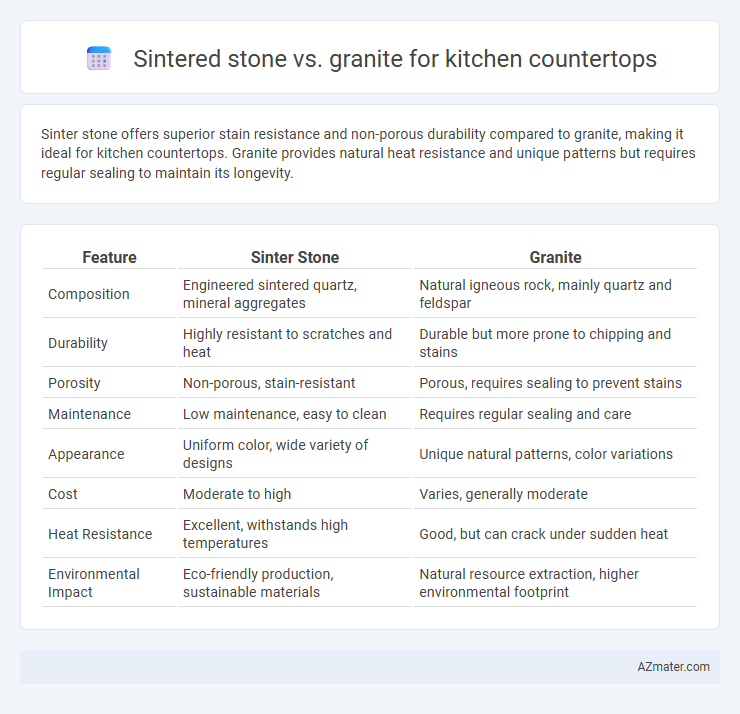Sinter stone offers superior stain resistance and non-porous durability compared to granite, making it ideal for kitchen countertops. Granite provides natural heat resistance and unique patterns but requires regular sealing to maintain its longevity.
Table of Comparison
| Feature | Sinter Stone | Granite |
|---|---|---|
| Composition | Engineered sintered quartz, mineral aggregates | Natural igneous rock, mainly quartz and feldspar |
| Durability | Highly resistant to scratches and heat | Durable but more prone to chipping and stains |
| Porosity | Non-porous, stain-resistant | Porous, requires sealing to prevent stains |
| Maintenance | Low maintenance, easy to clean | Requires regular sealing and care |
| Appearance | Uniform color, wide variety of designs | Unique natural patterns, color variations |
| Cost | Moderate to high | Varies, generally moderate |
| Heat Resistance | Excellent, withstands high temperatures | Good, but can crack under sudden heat |
| Environmental Impact | Eco-friendly production, sustainable materials | Natural resource extraction, higher environmental footprint |
What is Sinter Stone?
Sinter stone is an innovative engineered surface made from natural minerals such as quartz, porcelain, and glass fused under extreme heat and pressure, resulting in a highly durable and non-porous material. Unlike granite, which is a natural stone quarried directly from the earth and treated for use, sinter stone offers superior resistance to scratches, stains, and heat due to its advanced manufacturing process. This makes sinter stone an ideal choice for kitchen countertops requiring low maintenance and long-lasting performance.
What is Granite?
Granite is a natural igneous rock composed mainly of quartz, feldspar, and mica, known for its durability and heat resistance, making it a popular choice for kitchen countertops. Its unique, speckled appearance is created by the interlocking mineral grains formed during the slow cooling of magma beneath the Earth's surface. Granite countertops offer strong resistance to scratches and stains, providing a long-lasting and visually appealing surface for kitchen use.
Appearance and Design Versatility
Sinter stone offers a sleek, consistent appearance with a matte or polished finish that mimics natural stone while allowing for uniform colors and patterns ideal for modern kitchen designs. Granite features a rich, natural variation with unique veining and colors, providing a classic, timeless look that suits traditional and rustic kitchens. Both materials provide design versatility, but sinter stone excels in customization options due to its engineered composition, enabling precise edge profiles and large slab sizes without seams.
Durability and Strength Comparison
Sinter stone and granite are both renowned for exceptional durability in kitchen countertops, with sinter stone exhibiting superior resistance to scratches, stains, and heat due to its manufacturing process involving compressed natural minerals. Granite offers robust strength and natural hardness but is more porous, requiring periodic sealing to maintain its resilience against moisture and bacterial infiltration. The enhanced density and engineered composition of sinter stone often provide a longer lifespan and greater structural integrity under heavy kitchen use compared to granite.
Maintenance and Cleaning Requirements
Sintered stone countertops require minimal maintenance due to their non-porous surface, which resists stains, scratches, and heat without needing sealing. Granite countertops demand regular sealing, usually once a year, to prevent staining and bacterial growth, and they require gentler cleaning with pH-balanced cleaners to maintain their polished look. Both materials are durable, but sintered stone offers easier cleaning and lower upkeep compared to the more maintenance-intensive granite.
Heat and Scratch Resistance
Sinter stone exhibits exceptional heat resistance, withstanding temperatures up to 1200degF, making it highly suitable for kitchen countertops exposed to hot pots and pans. Granite also offers strong heat resistance but is generally less durable against thermal shock compared to sinter stone. In terms of scratch resistance, sinter stone surpasses granite due to its dense, non-porous surface composed of compressed natural minerals, providing superior protection against knives and daily wear.
Stain and Chemical Resistance
Sintered stone offers superior stain and chemical resistance compared to granite, making it highly durable against acidic spills, oils, and harsh cleaning agents commonly found in kitchen environments. Granite, while naturally resistant to heat and scratches, is more porous and susceptible to staining without proper sealing and maintenance. Homeowners seeking a low-maintenance countertop with enhanced resistance to discoloration and chemical damage often prefer sintered stone for its long-lasting performance.
Cost and Value Analysis
Sinter stone countertops generally offer a lower initial cost compared to granite, making them an attractive option for budget-conscious kitchen renovations. Granite provides long-term value through its durability, resistance to heat and scratches, and the unique natural patterns that can increase home resale value. When choosing between the two, consider the balance between upfront investment and potential ROI, with granite often favored for premium kitchens while sinter stone caters to cost efficiency and modern aesthetics.
Environmental Impact and Sustainability
Sintered stone countertops offer superior environmental benefits compared to granite due to their manufacturing process, which uses natural minerals fused at high temperatures without resins or harmful chemicals, resulting in minimal waste and lower carbon emissions. Granite extraction involves quarrying that disrupts ecosystems, produces significant waste, and requires energy-intensive transportation, contributing to a larger carbon footprint. Sintered stone's durability and recyclability enhance its sustainability profile, making it a preferred choice for eco-conscious kitchen design.
Which is Better: Sinter Stone or Granite for Your Kitchen Countertop?
Sinter stone offers superior durability and resistance to heat, scratches, and stains compared to granite, making it ideal for high-traffic kitchen countertops. Granite, while natural and visually appealing with unique patterns, requires regular sealing and maintenance to preserve its appearance and prevent damage. For a low-maintenance, long-lasting countertop solution, sinter stone generally outperforms granite in performance and longevity.

Infographic: Sinter stone vs Granite for Kitchen countertop
 azmater.com
azmater.com